江苏省江阴市璜土中学七年级英语下册《Unit 1 Dream homes Checkout & Maintask》学案(无答案) 牛津版
- 格式:doc
- 大小:109.50 KB
- 文档页数:3
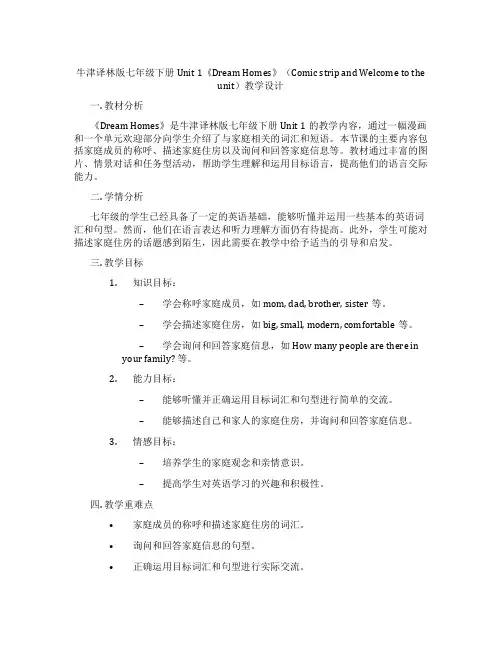
牛津译林版七年级下册Unit 1《Dream Homes》(Comic strip and Welcome to theunit)教学设计一. 教材分析《Dream Homes》是牛津译林版七年级下册Unit 1的教学内容,通过一幅漫画和一个单元欢迎部分向学生介绍了与家庭相关的词汇和短语。
本节课的主要内容包括家庭成员的称呼、描述家庭住房以及询问和回答家庭信息等。
教材通过丰富的图片、情景对话和任务型活动,帮助学生理解和运用目标语言,提高他们的语言交际能力。
二. 学情分析七年级的学生已经具备了一定的英语基础,能够听懂并运用一些基本的英语词汇和句型。
然而,他们在语言表达和听力理解方面仍有待提高。
此外,学生可能对描述家庭住房的话题感到陌生,因此需要在教学中给予适当的引导和启发。
三. 教学目标1.知识目标:–学会称呼家庭成员,如mom, dad, brother, sister等。
–学会描述家庭住房,如big, small, modern, comfortable等。
–学会询问和回答家庭信息,如How many people are there in your family? 等。
2.能力目标:–能够听懂并正确运用目标词汇和句型进行简单的交流。
–能够描述自己和家人的家庭住房,并询问和回答家庭信息。
3.情感目标:–培养学生的家庭观念和亲情意识。
–提高学生对英语学习的兴趣和积极性。
四. 教学重难点•家庭成员的称呼和描述家庭住房的词汇。
•询问和回答家庭信息的句型。
•正确运用目标词汇和句型进行实际交流。
•对听力材料的理解和家庭观念的表达。
五. 教学方法1.情境教学法:通过漫画和实际情境,让学生在真实的环境中学习和运用目标语言。
2.任务型教学法:通过完成各种任务,提高学生的语言实践能力和合作意识。
3.交际式教学法:鼓励学生积极参与课堂交流,提高他们的口语表达和听力理解能力。
六. 教学准备1.教材:牛津译林版七年级下册Unit 1《Dream Homes》。
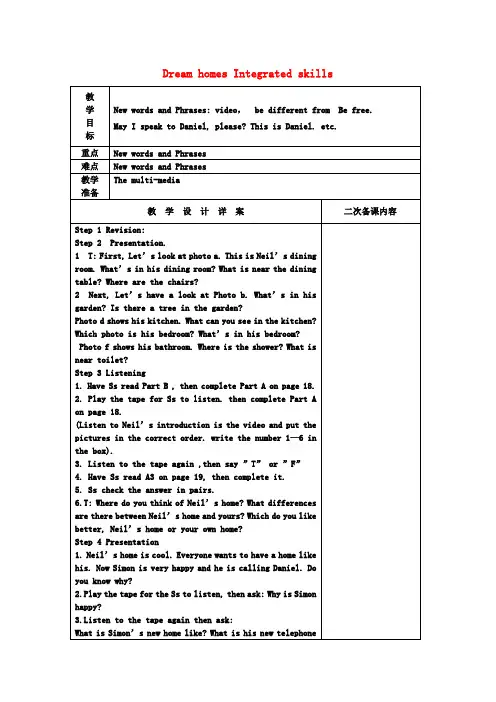
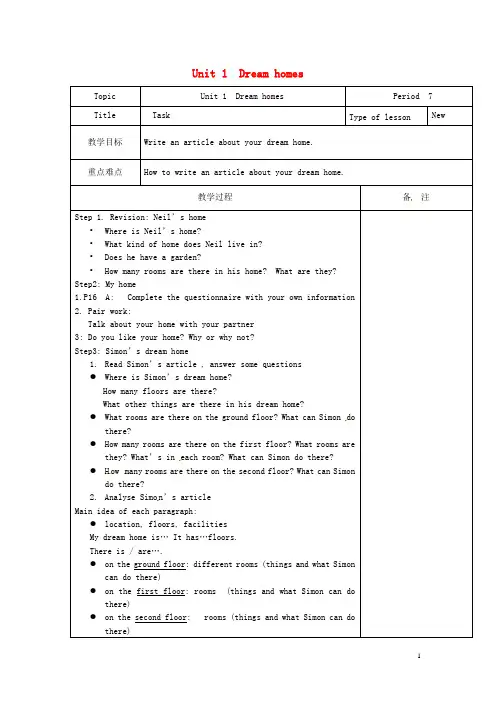
Unit 1 Dream homesTopic Unit 1 Dream homes Period 7 Title Task Type of lesson New 教学目标Write an article about your dream home.重点难点How to write an article about your dream home.教学过程备注Step 1. Revision: Neil’s home•Where is Neil’s home?•What kind of home does Neil live in?•Does he have a garden?•How many rooms are there in his home? What are they?Step2: My home1.P16 A: Complete the questionnaire with your own information2. Pair work:Talk about your home with your partner3: Do you like your home? Why or why not?Step3: Simon’s dream home1.Read Simon’s article , answer some questions●Where is Simon’s dream home?How many floors are there?What other things are there in his dream home?●What rooms are there on the ground floor? What can Simon dothere?●How many rooms are there on the first floor? What rooms arethey? What’s in each room? What can Simon do there?●H ow many rooms are there on the second floor? What can Simondo there?2.Analyse Simo n’s articleMain idea of each paragraph:●location, floors, facilitiesMy dream home is… It has…floors.There is / are….●on the ground floor: different rooms (things and what Simoncan do there)●on the first floor: rooms (things and what Simon can dothere)●on the second floor: rooms (things and what Simon can dothere)There is/are…on the ground/first/second… floor.There is/are always enough…there.I would like to invite my friends to…My friends like to…It is great fun.3: Write an article about your dream homeA: DISCUSSION1.Whe re is your dream home?2.W hat kind of home would you like to live in?3.How many rooms would you like to have in your dream home?4.What are the rooms?5. How many people will live in your dream home?6.What would you like to do in it?7.Do you want to invite your friends to stay with you in your dream home?8. Do you have any special ideas about your dream home?B:Your own dream home●Where?How many f loors?What other things are there?●What rooms are there on the ground floor? What can you dothere?●How many rooms are there on the first floor? What rooms arethey? What’s in each room? What can you do there?●How many rooms are there on the second floor? What can youdo there?C: Sample writing:My dream home is a big house at the top of the hill. It has four floors. There is a beautiful garden in front of it.On the grou nd floor, there is a big room for parties. There is a karaoke machine there. There is als o a small cinema. I often watch videos and DVDs there.On the first floor, there are eight bedrooms. Each bedroom has a small swimming pool and a huge TV set.The second floor is for my dog. She has lots of toys there. There are some computer rooms on the third f loor. I have more than enough computer games for my friends and myself.This is my dream home. I hope my dream comes true some day. Homework板书设计Unit 1 Dream homesTask1.Where is your dream home?2.What kind of home would you like to live in?3.How many rooms would you like to have in your dream home?4.What are the rooms?5. How many people will live in your dream home?6.What would you like to do in it?7.Do you want to invite your friends to stay with you in your dream home?8. Do you have any special ideas about your dream home?教学反思。
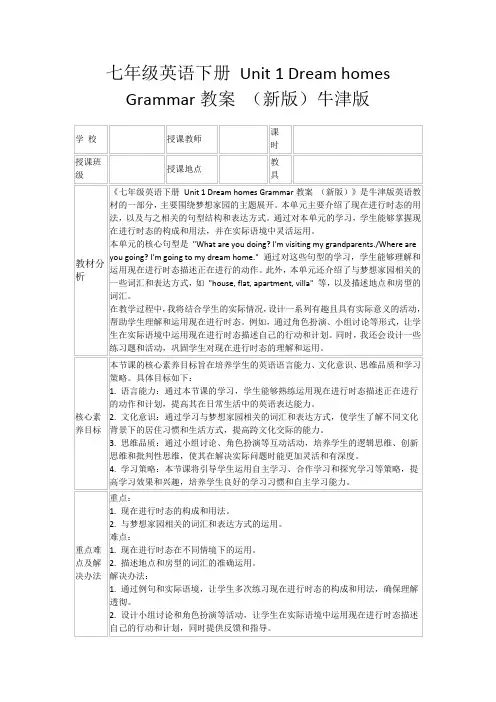
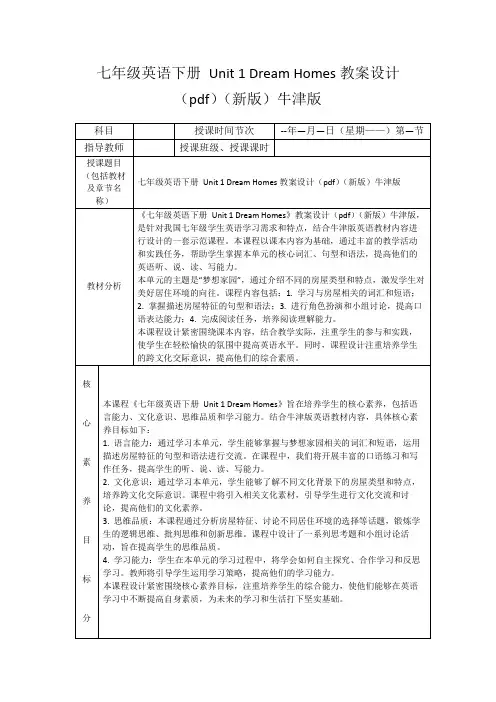
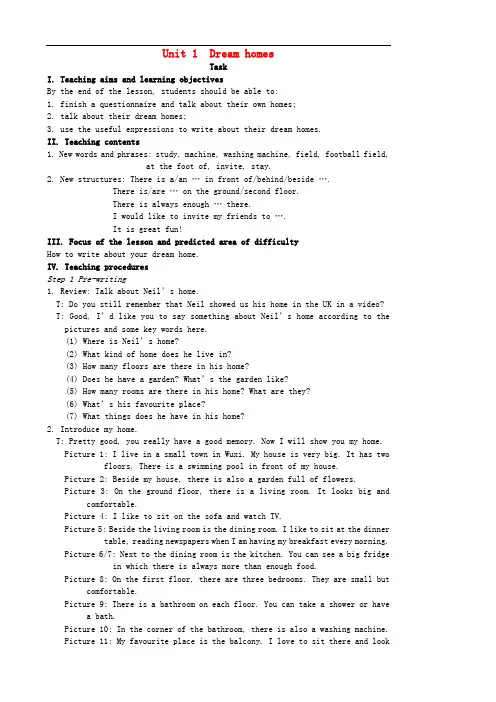
Unit 1 Dream homesTaskI. Teaching aims and learning objectivesBy the end of the lesson, students should be able to:1. finish a questionnaire and talk about their own homes;2. talk about their dream homes;3. use the useful expressions to write about their dream homes.II. Teaching contents1. New words and phrases: study, machine, washing machine, field, football field,at the foot of, invite, stay.2. New structures: There is a/an … in front of/behind/beside ….There is/are … on the gr ound/second floor.There is always enough … there.I would like to invite my friends to ….It is great fun!III. Focus of the lesson and predicted area of difficultyHow to write about your dream home.IV. Teaching proceduresStep 1 Pre-writing1. Review: Talk about Neil’s home.T: Do you still remember that Neil showed us his home in the UK in a video?T: Good, I’d like you to say something about Neil’s home according to the pictures and some key words here.(1) Where is Neil’s home?(2) What kind of home does he live in?(3) How many floors are there in his home?(4) Does he have a garden? What’s the garden like?(5) How many rooms are there in his home? What are they?(6) What’s his favourite place?(7) What things does he have in his home?2. Introduce my home.T: Pretty good, you really have a good memory. Now I will show you my home.Picture 1: I live in a small town in Wuxi. My house is very big. It has two floors. There is a swimming pool in front of my house.Picture 2: Beside my house, there is also a garden full of flowers.Picture 3: On the ground floor, there is a living room. It looks big and comfortable.Picture 4: I like to sit on the sofa and watch TV.Picture 5: Beside the living room is the dining room. I like to sit at the dinner table, reading newspapers when I am having my breakfast every morning.Picture 6/7: Next to the dining room is the kitchen. You can see a big fridge in which there is always more than enough food.Picture 8: On the first floor, there are three bedrooms. They are small but comfortable.Picture 9: There is a bathroom on each floor. You can take a shower or havea bath.Picture 10: In the corner of the bathroom, there is also a washing machine.Picture 11: My favourite place is the balcony. I love to sit there and lookout at the garden.Picture 12/13: There is a very big dinner table on the balcony. At the weekends,I like to invite my friends to come for dinner. It is great fun!3. Complete a questionnaire.T: Well, I sho wed you my home. Now I’d like to know yours. So would you please first complete the questionnaire in Part A on Page 16?4. Talk about your home.T: Ask and answer the following questions with your partner.(1) Where is your home?(2) What kind of home do you live in?(3) How many floors are there in your home?(4) Do you have a garden?(5) How many rooms are there in your home?(6) What are they?(7) How many people live in your home? Who are they?(8) What things do you have in your home?5. Watch a video.T: You really have fun talking about your own homes. Do you like your home? Do you want a better one? I guess at the bottom of everybody’s heart, there isa dream home. Now let’s watch a video.6. Read Simon’s article.7. The structure of Simon’s art icle.8. Talk about your dream home.Step 2 While-writingStep 3 Post-writing1. Evaluate their writing.T: Exchange your article with your partner and grade it according to the assessment table here. If you find some mistakes, try to correct them. If you find some good expressions or ideas, you can underline them. You can ask me for help if you have any problem.2. Give advice.T: After grading, please write down your advice on your partner’s article.If the article gets 18-20 points, you can write down “Well done! Keep on!”If it gets 15-17 points, you can write down “Not bad. Need to practice more!”If it gets 10-14 points, you can write down “Not good. Need to practice a lot!”3. Enjoy some good articles.T: I f your partner’s article gets 18-20 points, please stand up and read the article out.V. Homework1. Read your article again.2. Revise your article.。
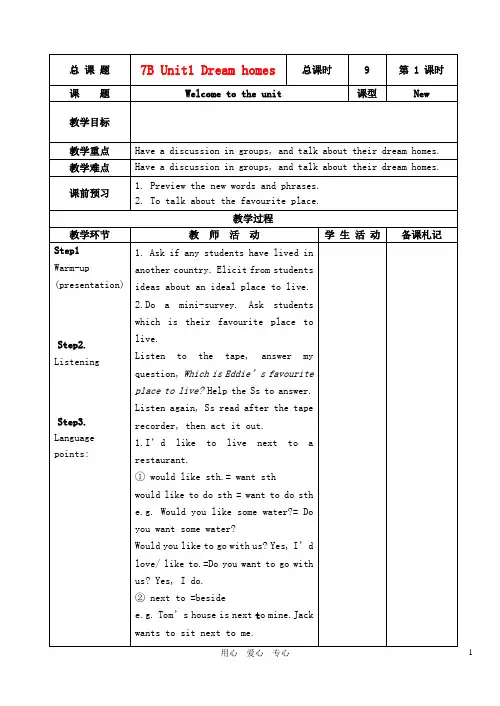
江苏省金山中学英语学科教案
江苏省金山中学英语学科教案
初一年级教案活页纸主备人:尹娟审核人:初一英语组全体老师
江苏省金山中学英语学科教案
初一年级教案活页纸主备人:尹娟审核人:初一英语组全体老师
江苏省金山中学英语学科教案
江苏省金山中学英语学科教案
初一年级教案活页纸主备人:尹娟审核人:初一英语组全体老师
初一年级教案活页纸主备人:尹娟审核人:初一英语组全体老师
江苏省金山中学英语学科教案。

Unit One Dream homes学习目标本单元介绍了一些国家首都所在地的某些标志性建筑物;创设了用数词谈论不同数量国家的人口和面积、所住的楼层、记录电话信息等具体的生活语言实践活动;重点介绍了尼尔、安娜和斯蒂芬所处三个不同国家不同风格的家园及尼尔为自己新家所拍摄的录像。
通过学习要能拓展知识面,讲出家里某些常用家俱的英文名称;掌握基数词与序数词的构成及用法;了解单词中重读音的规则;能模仿所学内容,以口、笔头形式描述自己现在的及理想中家园的概况,培养自己爱家,爱父母的情感。
重点难点1.重点词汇及短语词汇及短语相关提示(1) town n. 镇,市镇辨析town及city。
(2) country n. 国家辨析country, nation及state。
(3)mile n. 英里了解英里与公里的转换。
(4) centre n. 中心(英)了解美国英语的拼法及middle与用法区别。
(5) own adj. 自己的 v. 拥有掌握其作不同词性的用法。
(6) grow v.. 种植; 生长注意其作系动词及构成短语的用法。
(7)over prep. 超过;在……上方掌握其不同含义的不同用法。
(8)double adj. n. 双(的);两倍(的)掌握其在句中的不同用法。
(9) invite v. 邀请掌握其在句中的不同搭配及用法。
(10) stay vi n. 停留,逗留掌握其作不同词性的用法。
(11) share sth. with sb. 了解share作名词的用法。
与某人分享/合用某物(12) be full of 满是辨析be full of及be filled with。
(13) of one’s own 属于某人自己的辨析of one’s own及on one’s own。
(14) take a message 稍个口信掌握其在电话用语中的用法。
(15) at the foot of 在……的脚下掌握at the … of的其他短语。
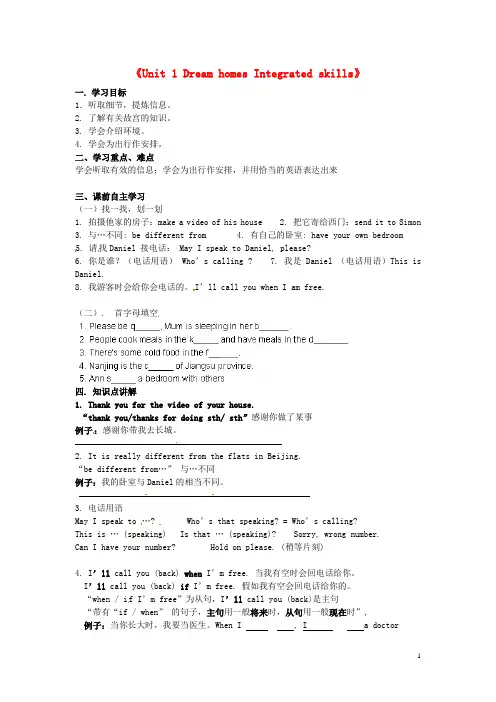
《Unit 1 Dream homes Integrated skills》一.学习目标1.听取细节,提炼信息。
2. 了解有关故宫的知识。
3. 学会介绍环境。
4. 学会为出行作安排。
二、学习重点、难点学会听取有效的信息;学会为出行作安排,并用恰当的英语表达出来三、课前自主学习(一)找一找,划一划1. 拍摄他家的房子:make a video of his house2. 把它寄给西门:send it to Simon3. 与…不同: be different from4. 有自己的卧室: have your own bedroom5. 请找Daniel 接电话: May I speak to Daniel, please?6. 你是谁?(电话用语)Who’s calling ?7. 我是Daniel (电话用语)This is Daniel.8. 我游客时会给你会电话的。
I’ll call you when I am free.(二). 首字母填空四. 知识点讲解1. Thank you for the video of your house.“thank you/thanks for doing sth/ sth”感谢你做了某事例子:感谢你带我去长城。
2. It is really different from the flats in Beijing.“be different from…”与…不同例子:我的卧室与Daniel的相当不同。
3. 电话用语May I speak to …? Who’s that speaking? = Who’s calling?This is … (speaking) Is that … (speaking)? Sorry, wrong number.Can I have your number? Hold on please. (稍等片刻)4. I’ll call you (back) when I’m free. 当我有空时会回电话给你。
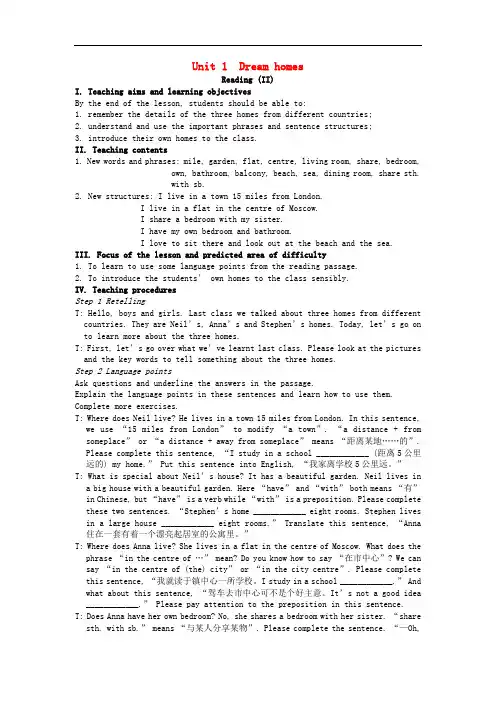
Unit 1 Dream homesReading (II)I. Teaching aims and learning objectivesBy the end of the lesson, students should be able to:1. remember the details of the three homes from different countries;2. understand and use the important phrases and sentence structures;3. introduce their own homes to the class.II. Teaching contents1. New words and phrases: mile, garden, flat, centre, living room, share, bedroom,own, bathroom, balcony, beach, sea, dining room, share sth.with sb.2. New structures: I live in a town 15 miles from London.I live in a flat in the centre of Moscow.I share a bedroom with my sister.I have my own bedroom and bathroom.I love to sit there and look out at the beach and the sea.III. Focus of the lesson and predicted area of difficulty1. To learn to use some language points from the reading passage.2. To introduce the students’ own homes to the class sensibly.IV. Teaching proceduresStep 1 RetellingT: Hello, boys and girls. Last class we talked about three homes from different countries. They are Neil’s, Anna’s and Stephen’s homes. Today, let’s go on to learn more about the three homes.T: First, let’s go over what we’ve learnt last class. Please look at the pictures and the key words to tell something about the three homes.Step 2 Language pointsAsk questions and underline the answers in the passage.Explain the language points in these sentences and learn how to use them. Complete more exercises.T: Where does Neil live? He lives in a town 15 miles from London. In this sentence, we use “15 miles from London”to modify “a town”. “a distance + from someplace” or “a distance + away from someplace” means “距离某地……的”.Please complete this sentence, “I study in a school ____________ (距离5公里远的) my home.” Put this sentence into English, “我家离学校5公里远。
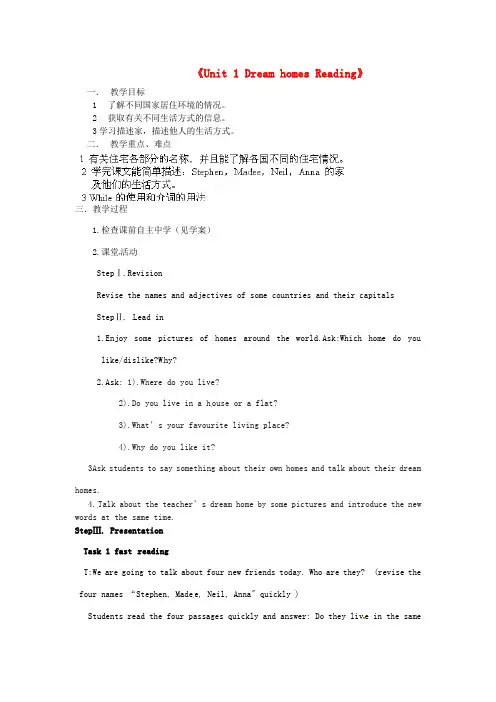
《Unit 1 Dream homes Reading》一.教学目标1了解不同国家居住环境的情况。
2获取有关不同生活方式的信息。
3学习描述家,描述他人的生活方式。
二.教学重点、难点三.教学过程1.检查课前自主中学(见学案)2.课堂活动StepⅠ.RevisionRevise the names and adjectives of some countries and their capitalsStepⅡ. Lead in1.Enjoy some pictures of homes around the world.Ask:Which home do youlike/dislike?W hy?2.Ask: 1).Where do you live?2).Do you live in a h ouse or a flat?3).What’s your favourite living place?4).Why do you like it?3Ask students to say something about their own homes and talk about their dreamhomes.4.T alk about the teacher’s dream home by some pictures and introduce the new words at the same time.StepⅢ. PresentationTask 1 fast readingT:We are going to talk about four new friends today. Who are they? (revise the four names “Stephen, Made e, Neil, Anna" quickly )Students read the four passages quickly and answer: Do they liv e in the samecountry? Wh ere do they live?Task 2 listeningListen to the tape and answer some questions:Is Stephen’s favorite place the balcony?What kind of house does Madee live in ?Where does Neil’s dog sleep?Are Anna’s neighbours friendly?Task 3 intensive readingStudents read after the tape and translate some useful expressions.Task 4 practicingDoing some exercise to consolidate the understanding.Finish PartB2 、 C1 and C2Task 5 speakingRev ise the text again and then try to retell.Task 6 discuss ionEast ,west, ho me is best!StepⅣ Homework。
一.教学目标1.To revise and use cardinal numbers in everyday situations , including phone numbers and amounts of money.2.To understand the purpose of ordinal numbers in terms of ordering things and events.3.To use ordinal and cardinal numbers to talk about schedules, dates, scores and results.二.教学重点、难点cardinal numbers & ordinal numbers三、教学过程1. 基数词的读法:⑴“几十几”十位和个位之间用“—”。
e.g. 32 thirty-two⑵101—999 百位和十位间加“and”.e.g. 928 nine hundred and twenty-eight⑶1000以上的数,从后往前每三位一段,倒数第一个数读thousand,倒数第二个数读million,依次类推。
e.g. 8,542,601 eight million, five hundred and forty-three thousand, six hundred and one2. 基数词的运用:hundred, thousand, million, billion等一般用单数,但以下情况用复数:⑴表示不定数目:e.g. hundreds of millions of⑵表示“几十”的数词,其复数形式可以表示年龄或年代。
e.g. in his twenties in the thirties.四.知识点讲解(见学案) 五.课后巩固(见学案) 课后反思:。
《Unit 1 Dream homes Grammar(1)》一.教学目标1、学习地点介词: above, at, behind, below, beside, between, in, in front of , inside, next to, on , opposite, over, under.2、通过对地点介词这一知识点掌握,学会此知识点运用.三、教学过程Step 2. Presentation— talk about the things in the classroom1.T: There are many thi ngs in our classroom. They are some pictures, two blackboards,a map and a teacher’s desk. (Ask stud ents where they are. Help students to say out the Prepositions of place and show them on the blackboard)T: Where is the cha lk? S: It is in the b ox.T: Where is the box? S: It is on the teachers’desk.T: Where is the teachers’desk? S: It is in front of the blackboard.T: Where is the blackboard? S: It is in the front of the classroom.T: Where is the other blackboard? S: It is opposite this one.T: W here are the curtains? S: They are next to/ beside the windows.T: Where are the windows? S: They are between the doors.T: Where are the brooms? S: They are behind the door.T: Where is the TV? S: It is above th e blackboard.T: Then where is the blackboard? S: It is below the TV.T: Where are the lights? S: They are over the desks.T: Then where are the desks? S: They are under the lights.2. Read these prepositions of place, get students to pay attention to the following key points成反义词:above—below,over—under,inside—outside,in front of —behind有关联的:above—over—on,below—under beside—next to,a t一in between—among 3.Get stud ents to practise saying these sentences above in oral.Step 3: Finishing tasks.Use these prepositions of place to talk about: Where are you, he/she and I? Open the books. Read the sentences in PartA on page13.四.知识点讲解五.课后巩固(见学案)课后反思。
Unit 1 Dream homesComic strip & Welcome to the unitI. Teaching aims and learning objectivesBy the end of the lesson, students should be able to:1. understand and act out the comic strip;2. correctly say the name, the capital, a place of interest, the language and thepeople of the six countries on Page 7.II. Teaching contents1. New words and phrases: palace, town, Canada, France, Japan, Russia, UK, London,country, capital, next to2. New structures: I’d like to live next to a restaurant.There are twenty restaurants in town.The biggest one in Fifth Street!Is Tokyo the capital of Japan?III. Focus of the lesson and predicted area of difficulty1. To read the proper nouns on Page 7 correctly and remember them well.2. To get enough information for the conversation from the teacher’s presentationand the discussion with classmates.3. To talk about the student s’ own favourite countries.IV. Teaching proceduresComic stripStep 1 Lead-inFree talk(1) How was your winter holiday?(2) Did you have a good time?(3) What did you do?(4) Where did you go?(5) What was the best part of your winter holiday?Step 2 Presentation1. Watch and answer.T: Eddie and Hobo are also talking about their dream homes. Watch the cartoon and answer the questions: Would Eddie like to live in a palace? Do you understand the meaning of this new word “palace”?2. Read and learn.T: Let’s open the book and tell me where Eddie would like to live.T: Good! What does “next to” mean in Chinese? And what about “fifth”? 3. Language points.T: Read aloud after the tape and learn the language points.(1) would like to do … = want to do(2) live in a palace(3) live next to a restaurant(4) in town(5) the biggest one in Fifth StreetStep 3 Practice1. Play roles and practise in pairs.T: Work in pairs and act out the story. I’ll ask some pairs to act in front of the class.2. Complete a short story.Welcome to the unitStep 1 Part A1. Presentation and learn.Show pictures to learn about different countries: Japan, the USA, France, Canada, the UK and Russia.JapanT: Boys and girls, please look at the picture. Who knows the name of this place?T: Yes, it’s Mount Fuji. There is thick white snow at the top of the mountain all year round. The view in and around this mountain is really wonderful. Do you know which country it is in?T: That’s right. It’s in Japan. Mount Fuji is near Tokyo, the capital of Japan.Do you understand the meaning of “capital”?T: What do we call the people who live in Japan? Yes, we call them Japanese or Japanese people. And “Japanese”also means the language that Japanese people speak.T: We’ve learnt something about Japan. Would you please say something about this picture or this country? For example, the capital of Japan is Tokyo. Who’d like to go on?T: Good job! So much for this picture. Now, look at the next picture.2. Look and match.Finish Part A on Page 7.3. Complete and say.T: We’ve learnt a lot about different countries. Let me help you remember them well. Look at this table. First, would you please complete it?T: Would you please say several sentences about each country? You can first practise with your partner. Then I’ll ask some of you to report one of them to the class.Step 2 Part B1. Listen and answer.(1) Which picture are Annie and Simon talking about?(2) What do you know from their conversation?2. Read aloud.3. Make up similar conversations.Step 3 PracticeShow pictures of famous people from the six countries and ask the students to do the question chains. Vote for the best question and the best answer.T: I’ll show you some famous people from the six countries. Let’s do a “question chain”. Six questions for each of them. Let’s see who will raise the best question and who will give the best answer. Are you ready? OK. Let’s start from …T: Great! Most of you did a very good job. Which question and which answer do you think are the best?V. Homework1. Tell your parents about your favourite country among the six in English.2. Remember the new language points.。
《Unit 1 Dream homes Checkout & Maintask》
一、学习目标
1.Get the Ss to write an article about their dream home using Simon’s article
as model.
2.To use prepositions of place to describe where things are
3. To use cardinal and ordinal numbers to talk about where people live.
二、学习重点、难点
正确运用基数词和序数词来描述Simon’s home.
三、课前自主学习
四、知识点讲解
1. There are at least 25 rooms.
at least → at most
e.g. It will cost at least five dollars.
The little girl is two at least.
2.This means that lots of people can stay w ith me.
e.g. The red lights mean “stop.”
His work m eans everything to him.
3.There is a swimming pool which is 50 metres long.
4.I have a room with twelve showers and four baths.
with(prep.) → without(prep.)
I have a foreign friend with brown hair.
五、课后巩固
单选
( )1.They will arrive ___ Guangzhou _____ the fifth of July.
A. at, at
B. i n, in
C. in ,on
D. to ,to
( )2. They enjoy ______ volleyball .
A. play
B. plays
C. playing
D. to play
( )3.There is a tall tree ______ the two buildings
A. over
B. between
C. among
D. on
( )4.This is Joe ________.Who is _____?
A. speaking , this
B. talking ,that
C. speaking, that
D. saying ,that ( )5.I went to the Great Wall with my _______ last week.
A. family
B. house
C. home
D. room
( )6. Neil wi th his parents ________ TV in the sitting room now.
A. watches
B. watch
C. is watching
D. are watching
( )7.110,206 should be read _______________________.
A. one hundred, ten thousand, two hundred and six
B. one hundred and ten thousand and two hundred and six
C. one hundred and ten thousands and two hundreds and six
D. one hundred and ten thousand , two hundred and six
( )8. Your home is different _______ .
A. with mine
B. from mine
C. with me
D. from me
( )9.When will the train ______? It will ______ in Beijing in two hours’ time.
A. arrive, arrive
B. reach, reach
C. arrive, reach
D. get to, get to ( )10.Every spring , people often plant ______ trees to make our city beautiful.
A. million of
B. millions of
C. five millions
D. five million of
同义句型转换
1.You are in the shop. You can see the hospital is in front of you . (同意句转换)
The hospital is _______ the shop.
2.I hav e a large room .It has 12 bathrooms. (同意句转换)
I have a large room ______ 12 bathrooms.
3.My friends thinks they can read some books there. (改为否定句)
My friends _________ think they _______ read any books there.
课后反思。